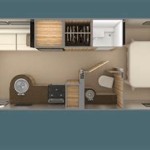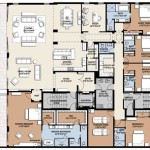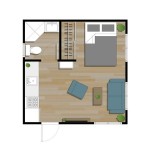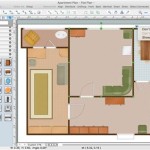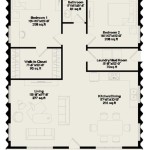
A floor plan is a scaled drawing that shows the layout of a building, including the arrangement of rooms, walls, doors, and windows. Floor plans are used for a variety of purposes, including architecture, interior design, and real estate. They can be used to plan the construction of a new building, to remodel an existing building, or to simply visualize the layout of a space.
There are a few different ways to get a floor plan of your house. One option is to contact the architect or builder who designed and built your home. They may have a copy of the original floor plan on file. Another option is to hire a professional surveyor to create a floor plan for you. Surveyors use specialized equipment to measure the dimensions of your home and create a detailed floor plan.
If you are comfortable with DIY projects, you can also create your own floor plan. There are a number of software programs that you can use to create floor plans, and there are also a number of online tutorials that can teach you how to use these programs.
Here are 9 important points about how to get a floor plan of your house:
- Contact the architect or builder
- Hire a professional surveyor
- Use a floor plan software program
- Find online floor plan templates
- Measure your home yourself
- Use a smartphone app
- Check with your local planning department
- Get a copy of your home’s title
- Consult with a real estate agent
Once you have a floor plan of your house, you can use it for a variety of purposes, such as:
- Planning a renovation or addition
- Designing a new interior layout
- Creating a furniture plan
- Estimating the square footage of your home
- Getting a home insurance policy
Contact the architect or builder
If you are fortunate enough to know the architect or builder who designed and built your home, they may have a copy of the original floor plan on file. This is the ideal scenario, as the original floor plan will be the most accurate and up-to-date.
- Pros:
Original floor plans are the most accurate and up-to-date.
Architects and builders are familiar with your home and can provide additional information if needed.
- Cons:
The architect or builder may not have a copy of the floor plan on file.
The architect or builder may charge a fee for providing a copy of the floor plan.
If you are unable to contact the architect or builder, or if they do not have a copy of the floor plan, there are other options available to you. You can hire a professional surveyor to create a floor plan, or you can create your own floor plan using a software program or online template.
Hire a professional surveyor
If you are unable to obtain a copy of the original floor plan from the architect or builder, or if you need a more accurate and up-to-date floor plan, you can hire a professional surveyor to create one for you.
- Pros:
Professional surveyors have the experience and expertise to create accurate and detailed floor plans.
Surveyors can use specialized equipment to measure the dimensions of your home and create a floor plan that is to scale.
Surveyors can also provide additional information on your property, such as the location of property lines and easements.
- Cons:
Hiring a professional surveyor can be expensive.
Surveyors may need to access the inside of your home to take measurements.
If you decide to hire a professional surveyor, be sure to get a clear understanding of the scope of work and the cost before signing a contract.
Use a floor plan software program
If you are comfortable with using a computer, you can create your own floor plan using a floor plan software program. There are a number of different software programs available, both free and paid. Some popular floor plan software programs include:
- SmartDraw
- Floorplanner
- RoomSketcher
- AutoCAD Architecture
- Chief Architect
Once you have chosen a floor plan software program, you can start creating your floor plan. The first step is to measure the dimensions of your home. You can do this using a tape measure or a laser measuring device. Once you have the measurements, you can start drawing the floor plan. Most floor plan software programs allow you to drag and drop walls, doors, and windows into place. You can also add furniture and other objects to your floor plan.
Once you have created a floor plan, you can save it to your computer or print it out. You can also share your floor plan with others online. Floor plan software programs are a great way to create accurate and detailed floor plans. They are also relatively easy to use, even for beginners.
Here are some of the benefits of using a floor plan software program:
- You can create accurate and detailed floor plans.
- You can easily edit and update your floor plans.
- You can share your floor plans with others online.
- Floor plan software programs are relatively easy to use, even for beginners.
If you are looking for a way to create a floor plan of your house, using a floor plan software program is a great option. Software programs are relatively inexpensive, and they can save you a lot of time and hassle.
Find online floor plan templates
If you are not comfortable using a floor plan software program, or if you are looking for a quick and easy way to create a floor plan, you can find online floor plan templates. There are a number of websites that offer free and paid floor plan templates. Some popular websites for finding floor plan templates include:
- Floorplanner
- RoomSketcher
- HomeByMe
- Planner 5D
- CAD Pro
Once you have found a website that offers floor plan templates, you can browse the templates and choose one that meets your needs. Most websites allow you to filter the templates by style, size, and number of rooms. Once you have found a template that you like, you can download it to your computer. You can then open the template in a floor plan software program or use it as a guide to create your own floor plan.
Using online floor plan templates is a great way to save time and hassle. Templates are also a good option for beginners who are not familiar with floor plan software programs. However, it is important to note that templates are not always accurate or up-to-date. If you need a precise and detailed floor plan, it is best to hire a professional surveyor.
Here are some of the benefits of using online floor plan templates:
- You can save time and hassle.
- Templates are a good option for beginners.
- You can find a wide variety of templates to choose from.
- Templates are relatively inexpensive.
If you are looking for a quick and easy way to create a floor plan of your house, using online floor plan templates is a great option. Templates are easy to use and can save you a lot of time and hassle. However, it is important to note that templates are not always accurate or up-to-date. If you need a precise and detailed floor plan, it is best to hire a professional surveyor.
Measure your home yourself
If you are comfortable with DIY projects and have some basic tools, you can measure your home yourself and create a floor plan. To do this, you will need a tape measure, a pencil, and some graph paper. You may also want to use a laser measuring device to get more accurate measurements.
To start, measure the length and width of each room in your home. Be sure to measure the dimensions of all closets, alcoves, and other architectural features. Once you have the measurements of each room, you can start to draw your floor plan on graph paper. Be sure to draw the floor plan to scale. This means that the dimensions of your floor plan should be proportional to the actual dimensions of your home.
Once you have drawn the outline of your floor plan, you can start to add the details. This includes doors, windows, furniture, and other objects. Be sure to label each room and include any important dimensions. Once you have finished adding the details, you will have a complete floor plan of your home.
Measuring your home yourself can be a time-consuming process, but it is a great way to save money. If you are not comfortable measuring your home yourself, or if you need a more accurate and detailed floor plan, you can hire a professional surveyor.
Use a smartphone app
There are a number of smartphone apps that can help you create a floor plan of your home. These apps are easy to use and can save you a lot of time and hassle. Some popular smartphone apps for creating floor plans include:
- MagicPlan
- RoomScan Pro
- Floor Plan Creator
- SmartDraw Floor Plan
- CAD Pro
To use a smartphone app to create a floor plan, simply download the app to your phone and follow the instructions. Most apps will ask you to take pictures of your home and then use those pictures to create a floor plan. Some apps also allow you to draw your own floor plan or use a template.
Once you have created a floor plan using a smartphone app, you can save it to your phone or share it with others. You can also export the floor plan to a PDF or CAD file.
Here are some of the benefits of using a smartphone app to create a floor plan:
- Smartphone apps are easy to use, even for beginners.
- Apps can save you a lot of time and hassle.
- Apps allow you to create accurate and detailed floor plans.
- Apps allow you to share your floor plans with others.
If you are looking for a quick and easy way to create a floor plan of your home, using a smartphone app is a great option. Apps are easy to use and can save you a lot of time and hassle. However, it is important to note that apps are not always as accurate as professional floor plans. If you need a precise and detailed floor plan, it is best to hire a professional surveyor.
Check with your local planning department
Your local planning department may have a copy of the floor plan for your house on file. This is especially likely if you live in a newer home or if your home has been remodeled or added to in recent years. To obtain a copy of your floor plan from your local planning department, you will need to contact the department and request a copy. There may be a small fee for this service.
- Benefits of checking with your local planning department:
Your local planning department may have the most up-to-date floor plan for your home on file.
Your local planning department may be able to provide you with other information about your home, such as its zoning and property lines.
- Drawbacks of checking with your local planning department:
Your local planning department may not have a copy of the floor plan for your home on file.
There may be a fee for obtaining a copy of your floor plan from your local planning department.
- Things to keep in mind when checking with your local planning department:
When contacting your local planning department, be sure to have your address and property information ready.
Be prepared to pay a fee for obtaining a copy of your floor plan.
- Alternatives to checking with your local planning department:
If your local planning department does not have a copy of the floor plan for your home on file, you may want to consider hiring a professional surveyor to create a floor plan for you.
You may also be able to find a copy of your floor plan online or through your home insurance company.
Checking with your local planning department is a good option if you need a copy of the floor plan for your home and you live in a newer home or if your home has been remodeled or added to in recent years. However, it is important to keep in mind that there may be a fee for this service and that your local planning department may not have a copy of the floor plan for your home on file.
Get a copy of your home’s title
Your home’s title is a legal document that shows who owns the property and any liens or encumbrances on the property. A title search is a process of examining public records to verify the ownership and legal status of a property. A title search can also reveal any easements, covenants, or other restrictions on the property.
- Why is a title search important?
A title search is important because it can help you to avoid buying a property that has hidden problems, such as liens, encumbrances, or title defects. A title search can also help you to determine the legal boundaries of your property and any easements or other restrictions that may affect your use of the property.
- How do I get a copy of my home’s title?
You can get a copy of your home’s title from the county recorder’s office in the county where your property is located. You will need to provide the recorder’s office with your name, address, and the property address. There is usually a small fee for obtaining a copy of your title.
- What information is included in a title search?
A title search will typically include the following information:
The legal description of the property
The names of the current owners of the property
Any liens or encumbrances on the property
Any easements or other restrictions on the property
A history of all ownership transfers and other transactions involving the property
What are some of the benefits of getting a title search?
There are many benefits to getting a title search, including:
Peace of mind knowing that you are buying a property with a clear title
Protection from buying a property with hidden problems, such as liens, encumbrances, or title defects
Help in determining the legal boundaries of your property
Help in identifying any easements or other restrictions that may affect your use of the property
Getting a title search is an important part of the home buying process. It can help you to avoid buying a property with hidden problems and protect your investment.
Consult with a real estate agent
If you are selling your home, a real estate agent can help you to create a floor plan of your home as part of the marketing materials. A floor plan can help potential buyers to visualize the layout of your home and to see how the different rooms flow together. This can be especially helpful for buyers who are looking for a home with a specific layout or who have a specific furniture arrangement in mind.
Real estate agents typically have access to software that can be used to create floor plans. They can also create floor plans by hand or by using a combination of software and hand-drawn elements. If you are working with a real estate agent, be sure to ask them if they can provide you with a floor plan of your home.
In addition to creating floor plans for marketing purposes, real estate agents can also use floor plans to help buyers and sellers to visualize potential renovations or additions. For example, a real estate agent can use a floor plan to show a buyer how a wall can be removed to create a more open floor plan or how an addition can be added to create more space.
If you are considering selling your home, consulting with a real estate agent is a good way to get a floor plan of your home and to learn about other marketing materials that can help you to sell your home quickly and for the best possible price.
Planning a renovation or addition
One of the most important steps in planning a renovation or addition is to create a floor plan. A floor plan is a scaled drawing that shows the layout of a building, including the arrangement of rooms, walls, doors, and windows. Floor plans are used for a variety of purposes, including planning the construction of a new building, remodeling an existing building, or simply visualizing the layout of a space.
When planning a renovation or addition, a floor plan can help you to:
- Visualize the new layout of your home.
- Plan the placement of new walls, doors, and windows.
- Estimate the cost of your renovation or addition.
- Get permits from your local building department.
- Avoid costly mistakes during construction.
There are a few different ways to create a floor plan. You can hire a professional architect or draftsman to create a floor plan for you, or you can create your own floor plan using a software program or online template.
If you decide to create your own floor plan, there are a few things to keep in mind:
- Start by measuring the dimensions of your existing home.
- Draw the outline of your home on graph paper or using a software program.
- Add the walls, doors, and windows to your floor plan.
- Label each room and include any important dimensions.
- Once you have created a floor plan, you can start planning your renovation or addition.
A floor plan is an essential tool for planning a renovation or addition. By taking the time to create a floor plan, you can avoid costly mistakes and ensure that your renovation or addition meets your needs and expectations.
Designing a new interior layout
A floor plan is also essential for designing a new interior layout. By creating a floor plan, you can experiment with different layouts and see how different furniture arrangements will work in your space.
- Start by measuring the dimensions of your room.
This will help you to create a scale drawing of your room and to plan the placement of your furniture.
- Draw the outline of your room on graph paper or using a software program.
Be sure to include all of the walls, doors, and windows.
- Add the furniture to your floor plan.
Use cut-outs of furniture or draw the furniture to scale. Experiment with different arrangements until you find one that you like.
- Label each room and include any important dimensions.
This will help you to keep track of the different spaces in your room and to plan the flow of traffic.
Once you have created a floor plan, you can start to make decisions about your new interior layout. A floor plan can help you to visualize the new layout of your room and to make sure that everything fits together before you start moving furniture.
Creating a furniture plan
A furniture plan is a scaled drawing that shows the arrangement of furniture in a room. Furniture plans are used for a variety of purposes, including:
- Planning the layout of a new room.
A furniture plan can help you to visualize the new layout of a room and to see how different furniture arrangements will work in your space.
- Rearranging furniture in an existing room.
A furniture plan can help you to experiment with different furniture arrangements in an existing room to find the best layout.
- Planning for a new furniture purchase.
A furniture plan can help you to determine the size and style of furniture that will best fit in your space.
- Creating a furniture inventory.
A furniture plan can help you to keep track of your furniture and to see what pieces you need to replace or repair.
To create a furniture plan, you will need to:
1. Measure the dimensions of your room. This will help you to create a scale drawing of your room and to plan the placement of your furniture.2. Draw the outline of your room on graph paper or using a software program. Be sure to include all of the walls, doors, and windows.3. Add the furniture to your floor plan. Use cut-outs of furniture or draw the furniture to scale. Experiment with different arrangements until you find one that you like.4. Label each piece of furniture. This will help you to keep track of the different pieces of furniture in your room and to plan the flow of traffic.Once you have created a furniture plan, you can start to make decisions about your new furniture layout. A furniture plan can help you to visualize the new layout of your room and to make sure that everything fits together before you start moving furniture.
Estimating the square footage of your home
Estimating the square footage of your home is a relatively simple process that can be done using a variety of methods. One common method is to use a floor plan. A floor plan is a scaled drawing that shows the layout of a building, including the arrangement of rooms, walls, doors, and windows. Floor plans can be used for a variety of purposes, including estimating the square footage of a home.
- Measure the dimensions of each room.
To estimate the square footage of your home using a floor plan, you will need to measure the dimensions of each room. This can be done using a tape measure or a laser measuring device. Once you have the dimensions of each room, you can calculate the square footage by multiplying the length of the room by the width of the room.
- Add the square footage of each room.
Once you have calculated the square footage of each room, you can add the square footage of all the rooms together to get the total square footage of your home. Be sure to include any finished spaces in your basement or attic in your calculations.
- Subtract the square footage of any unfinished spaces.
If your home has any unfinished spaces, such as a basement or attic, you will need to subtract the square footage of these spaces from the total square footage of your home. Unfinished spaces are typically not included in the square footage of a home because they are not considered to be habitable space.
- Adjust for any sloping ceilings.
If your home has any sloping ceilings, you will need to adjust your calculations to account for this. Sloping ceilings can reduce the amount of usable space in a room, so it is important to factor this into your calculations.
Once you have completed these steps, you will have a good estimate of the square footage of your home. This information can be useful for a variety of purposes, such as determining your property taxes, getting insurance, or planning a renovation.
Getting a home insurance policy
A floor plan is also essential for getting a home insurance policy. Home insurance companies use floor plans to determine the square footage of your home and to assess the risk of insuring your home. A floor plan can also help you to get a more accurate quote on your home insurance policy.
When you apply for a home insurance policy, the insurance company will ask you for a floor plan of your home. You can provide the insurance company with a copy of your original floor plan, or you can create your own floor plan using a software program or online template. If you create your own floor plan, be sure to include the following information:
- The dimensions of each room
- The location of all doors and windows
- The location of all plumbing and electrical fixtures
- The location of all major appliances
- The location of any fireplaces or wood stoves
Once you have created a floor plan of your home, you can submit it to the insurance company. The insurance company will use the floor plan to determine the square footage of your home and to assess the risk of insuring your home. A more accurate floor plan will help you to get a more accurate quote on your home insurance policy.
In addition to using a floor plan to determine the square footage of your home and to assess the risk of insuring your home, insurance companies also use floor plans to determine the amount of coverage you need. The amount of coverage you need will depend on the size of your home, the value of your belongings, and the type of coverage you choose. Your insurance agent can help you to determine the amount of coverage you need.
A floor plan is an essential tool for getting a home insurance policy. By providing the insurance company with a floor plan, you can help to ensure that you get the right amount of coverage at the right price.



/floorplan-138720186-crop2-58a876a55f9b58a3c99f3d35.jpg)





Related Posts

